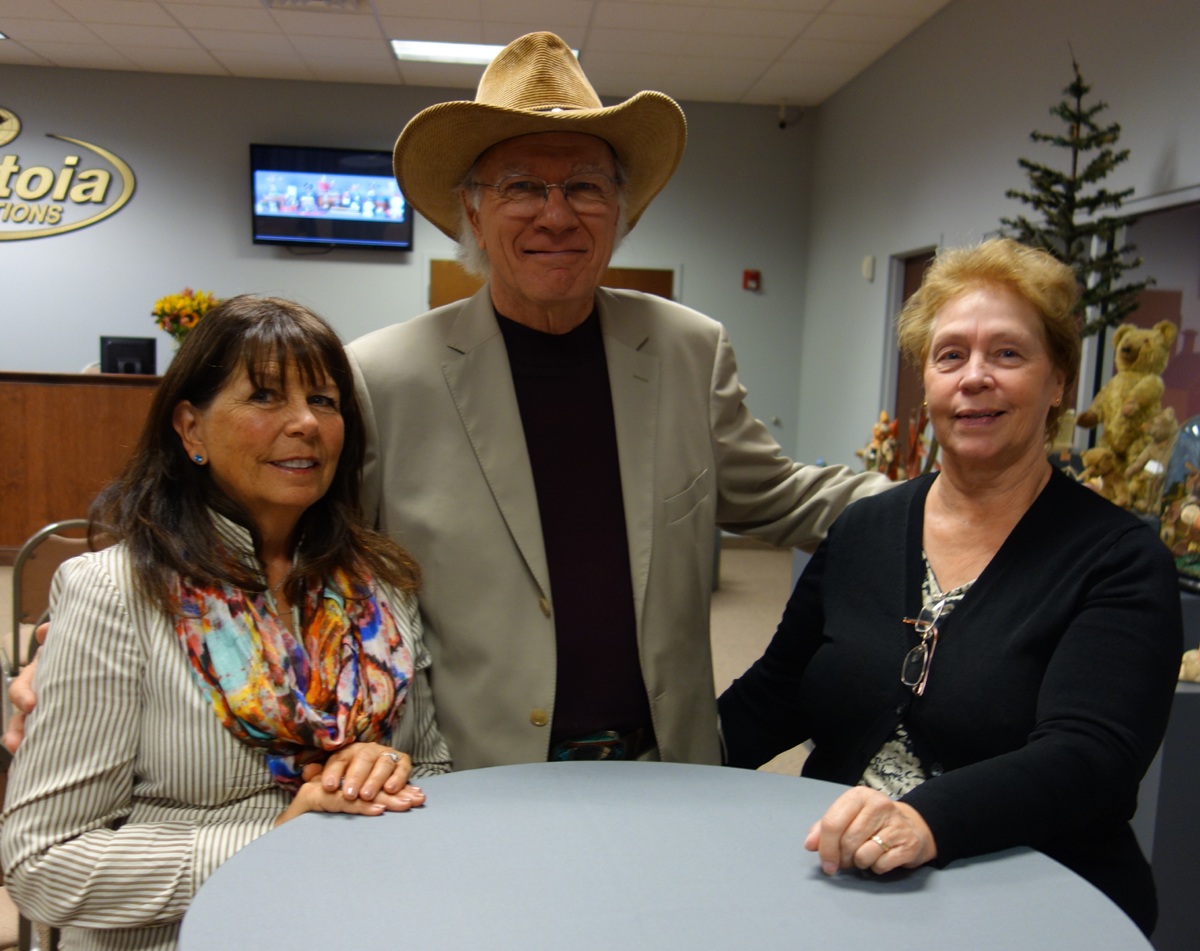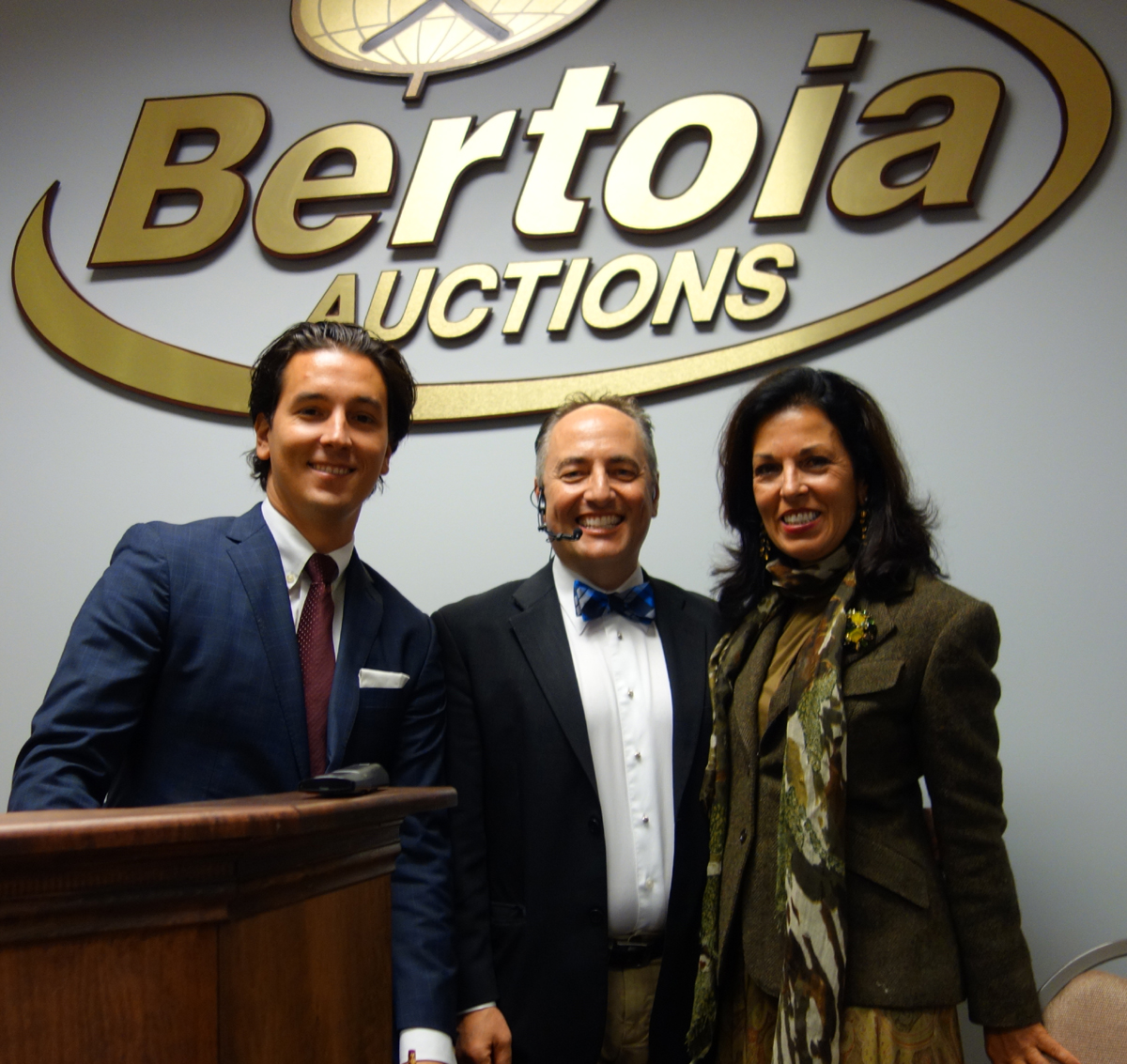Review and onsite Photos by R. Scudder Smith
Catalog photos courtesy Bertoia Auctions
VINELAND, N.J. — “I obtained most of the banks I have ever wanted and it is simply time…time to sell them,” Clive Devenish said about the collection that he formed over the past 40 years. And when it came down to picking a seller for the collection, he reflected back to 1978 when he first met Bill Bertoia at the Kennedy Toy Show in New York. “We had so many stories, deals and memories together over the years that we chose Jeanne and her team to handle the sale,” Clive said.
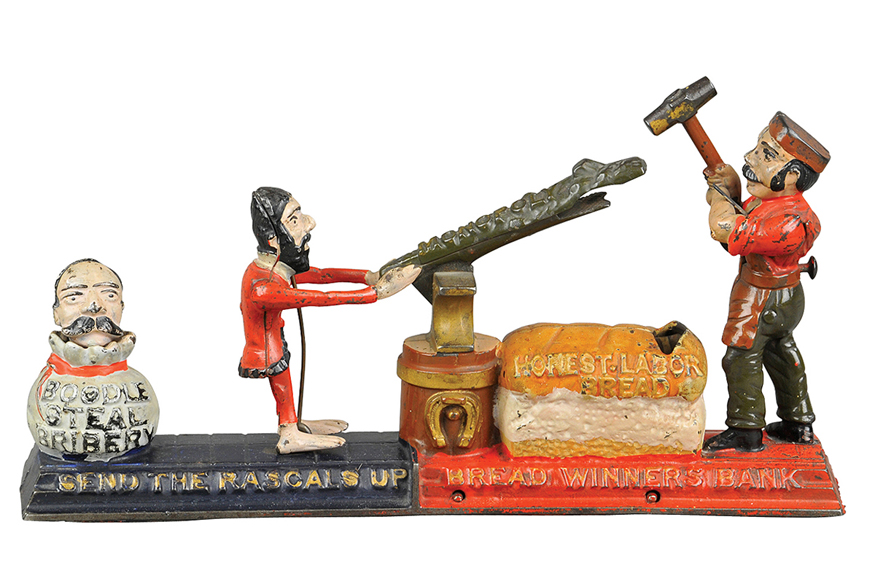
The Bread Winners mechanical bank opened at $40,000 and sold for $72,000, just under the high estimate. Made by J&E Stevens Co., Cromwell, Conn., cast iron, circa 1886, it is in near pristine condition and the provenance lists Ferdinand Weider.
Saturday, October 3, was picked months ago for Session One and an elaborate catalog showed off 178 lots of both mechanical and still banks that were sold. Little did anyone know that a major storm would be circling that area, but “in spite of Hurricane Joaquin making its timely presence known on the East Coast, Bertoia Auctions was able to ensure a very busy schedule of land lines for the much-awaited Clive Devenish bank collection,” Jeanne Bertoia said. She added, “I never saw so many last minute decisions going on in buyers’ faces, and proof of this intensity was demonstrated as banks that just missed the final reserve were swooped up in a hurry immediately after the sale and calls were coming in all during the following week.” This sale made it obvious to her that “interest for good banks is still at peak.”
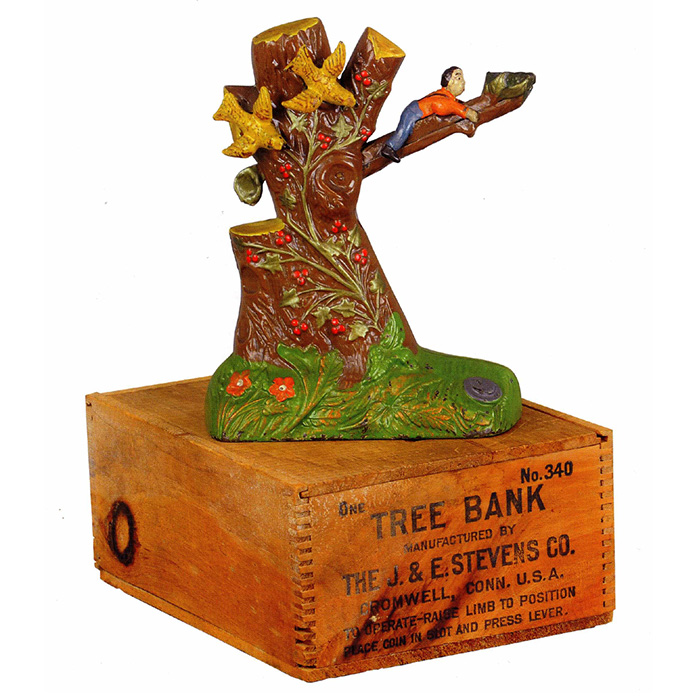
One of the top mechanical bank lots was Boy Robbing Bird’s Nest with box, J&E Stevens, Cromwell, Conn., cast iron, circa 1906. This is one of the finest examples known, near mint condition, and the provenance lists Walter P. Chrysler and Steven Steckbeck collections. It realized $42,000.
When Clive was asked “What is your favorite bank?,” his reply was quite out of the ordinary and not one expected. “My favorite bank is the next one I really want, and my second most favorite bank is the one I just bought,” Clive said. And he bought banks from many sources and all around the world. He bought from his first mentor, John Haley in England, and some from Donal Markey, his second mentor, whom he met through an ad he placed in the Antique Trader.
Over the years he bought from both collectors and dealers, including Ferdinand Weider, Leon Cameto, Ed Mosler, Charles Klappert and Morley Golden. He spent hours studying paint and interacted with collectors and dealers from all over the country. For years Clive sheltered his banks, keeping them in a closet, away from the light. After he bought his home in Lake Tahoe, he put them on exhibit in a “drape drawn room” and after 11 years made the decision to sell them all.
The sale grossed $1,015,980, including the buyer’s premium, and some of the sales are recorded here.
The auction started off with the Zoo mechanical bank, Kyser & Rex Mfg, Philadelphia, cast iron, circa 1890s, in excellent condition, that sold for $2,400, just under the low estimate, followed shortly by Elephant Three Star mechanical bank, unknown maker, cast iron, circa 1880s. According to the catalog, this example may be one of the finest known, painted midnight black with contrasting gold saddle with three red stars. When a coin is placed in the elephant’s trunk, the tail is pressed down and the animal throws the coin into its head. It sold in the gallery to a collector for $4,200, within estimate.
Jonah & The Whale bank, Shephard Hardware Co., New York, cast iron, circa 1890, in pristine condition, sold to an absentee bidder for $9,000, within estimate. The catalog notes, “One of the most fascinating visually appealing banks, this is one of the finest examples ever offered here, colors are astounding.” A few lots later, the Circus Ticket Collector mechanical bank by H.L. Judd Mfg. Co., Connecticut, cast iron, circa 1879, sold within estimate for $5,400. This example has nice japanning to the barrel and good paint to the face and jacket. When a coin is dropped into the barrel, the ticket collector shakes his head in thanks.
The Punch & Judy mechanical bank, small letters, Shephard Hardware Co., cast iron, patented 1884, went over the $10,000 high estimate, bringing $13,200. This example is vibrant and the action epitomizes the best in mechanical bank ingenuity. A Punch & Judy mechanical bank, English, was the next lot, selling for $8,400, above the high estimate. This example was by Harry James Banks & Sons, Ltd, Handsworth, England, patented in 1929. It is of electroplated cast iron and green tin stage area and the provenance lists Edwin Mosler and Steve Steckbeck collections.
The Vending mechanical bank — Chocolat Menier — French, lithographed tin 10¼ inches high, went just under estimate for $600, and a British Clown With Advertising mechanical bank, German, lithographed tin, circa 1920s, was also just under estimate at $4,200.
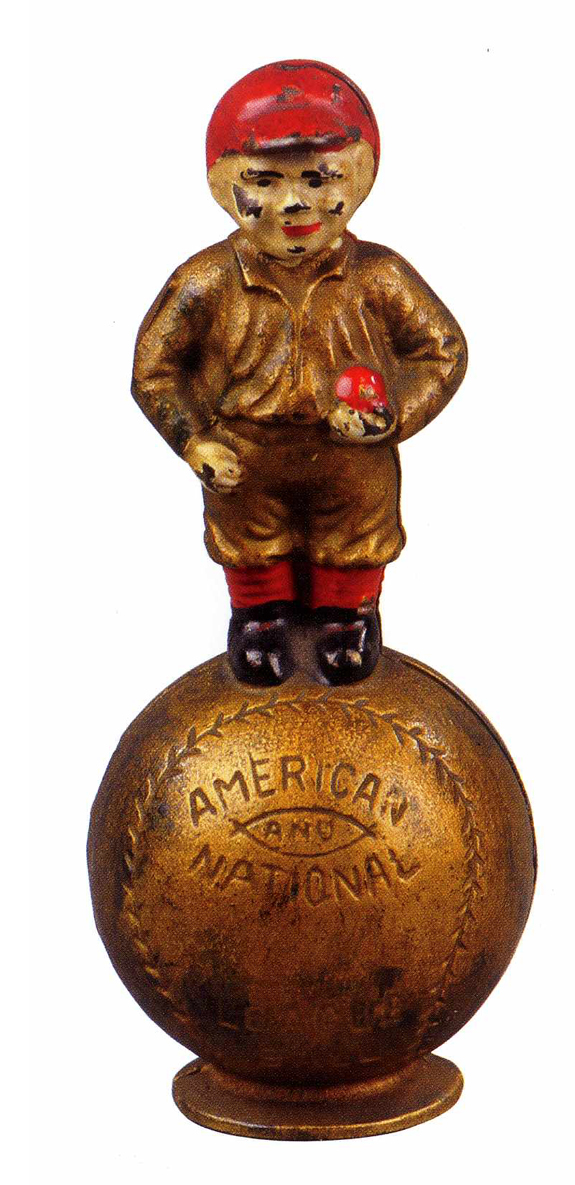
The highest price paid for a still bank in the auction was for lot 66, the Mascot, Hubley, Lancaster, Penn., cast iron and dating circa 1915, that went for $7,200.
Among the still banks was Mary and Lamb, USA, maker unknown, cast iron, circa 1900, 45/8 inches tall, that sold over estimate for $2,400 to a collector in the room. Mary is in a white dress with red trim and stockings, the lamb painted in gold. Another still bank, the Battleship Oregon by J&E Stevens, Cromwell, Conn., cast iron, circa 1902, 10¼ inches long, went just over the high estimate, selling for $6,600. The ship was painted white overall, with red life boat interiors and green base. It is all original, including the boats, masts and base plate, and the provenance lists Ferdinand Weider.
Eight continuous pages in the catalog pictured all still banks, including the Yellow Cab, Arcade Mfg Co., Freeport, Ill., cast iron and 7 inches long. Painted orange and black, with driver, it brought $1,080, just over the high estimate, and Fido On Pillow by Hubley, Lancaster, Penn., was of cast iron, and 73/8 inches high. It had well-detailed floral molding to the yellow pillow, and the dog was depicted with perked ears and coin slot at back. It sold over estimate for $960.
The Owl Turns Head mechanical bank (white owl), J&E Stevens Co., cast iron, circa 1880, in excellent condition, went within estimate for $9,000 to an absentee bidder. Three lots later, Chief Big Moon mechanical bank, with box, J&E Stevens Co., patented in 1899, went for $24,000, right in the middle of the estimate. This bank is the rare red base version and it came out of a private San Francisco estate in 1980.
Shephard Hardware’s Picture Gallery mechanical bank, circa 1885, came out of the Bob Stewart Collection and sold for $30,000 to a bidder in the gallery. It was listed as being in pristine condition.
A little over a dozen spelter banks were in the sale, including the popular Terrier On Basket, Germany, circa 1910–20, that sold in the room for $1,200, just over the high estimate. On top of the basket, along with the dog, is a book titled A Present from Aberdeen, and it retains its original lock. Also popular, and going just over the high estimate, was the Rabbit Head still bank, Heyde, Germany, circa 1900–10, that went for $1,320 to an absentee bidder. This well-detailed version has long ears and coin slot in the top of the head.
There were a number of Jolly “N” banks in the sale, including one by John Harper & Co., England, cast iron, in pristine condition with red jacket, yellow lapels and bowtie that went to a private collector in the room for $1,440. Shephard Hardware Co, patented the Trick Pony mechanical bank in 1885, and the example in the Devenish Collection was all original with wonderful paint showing great highlight colors on the saddle and ornate collar. In near mint condition, it came out of a private Seattle estate in 1991 and sold for $7,800, just shy of the high estimate. The always-popular Uncle Sam bank, this one with box, Shephard Hardware Co., cast iron, circa 1886, went to the Internet for $10,800. It is in excellent condition and was from the Ferdinand Weider Collection.
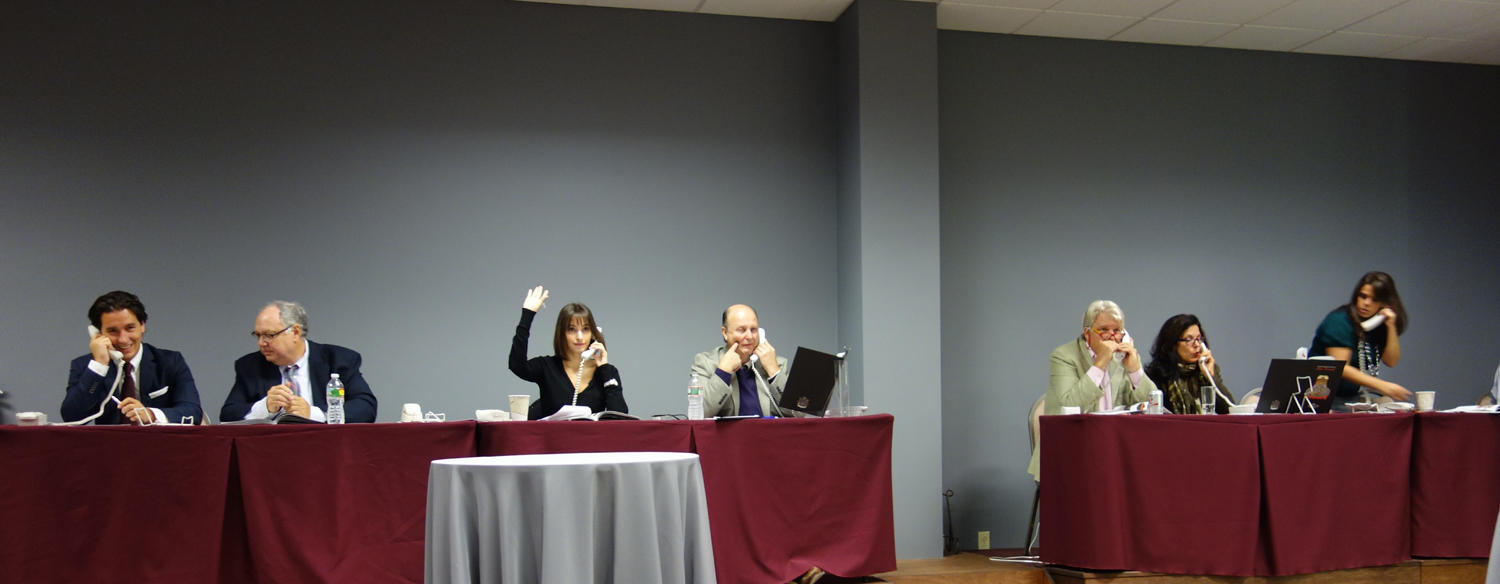
An active gallery at the back of the room taking the phone bids. Among the group are Jeanne Bertoia and son Michael.
The auction ended with the Ferris Wheel mechanical bank, Hubley, selling in the room for $10,800, over the $9,000 high estimate, to a bidder in the room. The bank is of great scale and clockwork action enabling complete revolutions with seated people in the gondolas. It is in excellent condition and the coin activates the clockwork mechanism when it is deposited.
“We have not set a date for the second session, but it will be next year in March, April or May,” Michael Bertoia said.

